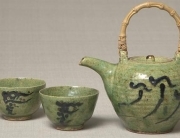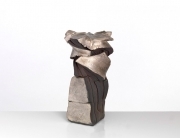Some words on Japanese Design
After the war, the development of graphic design in packaging, posters and magazines, is clearly inspired by Japanese traditions. In the 19th century, thanks to the prints that Japanese culture had become known in Europe. This export continued after 1945, even if, as in architecture and industrial design, graphic design Japanese began to integrate the concepts and ideals of the modern movement in Europe. This exchange of good practices reflected in the posters of Tadanori Yokoo and Yusaku Kamekura, among others.
The packaging was also a U.S. impact in the early years of the post-war American designer Raymond Loewy designed a pack of cigarettes for a tobacco Japanese inspired his famous creation for Lucky Strike. The 1964 Olympics would provide Japanese designers the opportunity to showcase their talents, and it is from this date that Japan developed a modern movement of graphic design, inspired by the European constructivism. Ikko Tanaka, Kiyoshi Awazu and Shigeo Fukuda are among the pillars of graphic design in the post-war period.
Influenced by pop-art sensibility that characterizes much of the Japanese graphic 1960s and 1970s, small bags looking like crumpled paper, porcelain and glass ceramic made by Makoto Komatsu in 1970 (as the Crinkle Tumbler, 1974), reflect the meeting of the artisan tradition and pop culture conveyed by the mass media. Japan has always sought to unite the people and everyday while celebrating the talent of artisans, and Komatsu works perfectly able to continue this alliance into the period after the war.
By the mid-1980s, the modern Japanese design had acquired its final form. Architecture, interior design, high-tech products, graphic design, crafts, textiles and fashion Japanese had their place now widely in international exhibitions, and their influence was undeniable. Western designers began to visit Japan and discover its traditions and to work in the stimulating environment of Japanese design, which incorporated new technologies without reservation.
With the globalization movement that began sometime in the 1980s, national borders are completely powerless to contain anything, and this also applies to the design. The flow of international trade encourages the development of hybrid crops.
In the field of design, the concept of hybridity gave rise to more creativity and innovation. In 1982, Makio Hasuike Way MH founded in Milan. He moved to Italy in 1963. The aesthetic creations of Hasuike, purity, clarity, simplicity, transparency, portability, passion for materials and textures are deeply rooted in the Japanese tradition. Its range of stationery, which included among other pens, pencils and calendars, had many points in common with simple everyday objects created later by Muji brand “unbranded”, which won a worldwide success in the 1990s.
In 1981, the first exhibition of the works of the Memphis group in Milan marked a crucial moment in the history of Japanese designers in Italy. Directed by Ettore Sottsass, Italian designer veteran Memphis ambition was to renew the language of contemporary design, and three Japanese designers, Arata Isozaki, Shiro Kuramata, and Masanori Umeda, were invited to participate in the adventure. Their works were among the most innovative exhibition, demonstrating that Japan was no longer to follow the European avant-garde, but he was playing with it or even, as some thought, he took head.
In the 1980s, Japan experienced a rapid transition and witnessed the birth of a new type of consumer society: the most popular products became those who were inspired by popular culture. Electrical appliances painted pink for a clientele of young girls, side by side on the shelves with products kawaii (cute), such as speakers Bubble Boy Tomoyuki Sugiyama (1986), while everyday objects such foods in plastic and electrical gadgets anonymous, were more numerous in the stores and in society as a whole.
The coexistence of consumer products and popular imagery, manga and Ninja Turtles, for example, and a campaign to save traditional craftsmanship was only an extension of the two levels of material culture that coexisted in Japan for many years.
The economic recession of the 1990s brought changes irrevocable. The economic expansion that had led to the emergence of the Japanese culture of post-war development of industry giants who dominated the international market was put into perspective by the sudden downturn. The pendulum between gadgets and ephemeral popular culture, suddenly we preferred the universality of design activities centered around the craft.
The architecture and interior design, and returned to the front of the stage, and both disciplines showed again they drew their inspiration from the Japanese tradition. The anonymity of designers employed by large companies gave way to a world where the individual was more appropriate, and in which, as Western media creatives, designers were considered artists, capable of creativity and poetry.
A new generation of designers remarked in the 1990s: many of them had studied and worked with more experienced designers like Issey Miyake and Shiro Kuramata, whose talent was demonstrated in the 1960s and 1970s. The untimely death of Kuramata in 1991 was for Japan and the rest of the world, an opportunity to reflect on the origins of Japanese design and the direction he was taking. This reflection was illustrated by several exhibitions centered around the work of Kuramata or Japanese design in general since 1950. Better yet, the process of internationalization and globalization that began in the previous decade took speed shortly after 1990, and designers have moved more easily from one country to another.
Industrial design, one of the branches of Japanese design the most active in the early 1990s, took a new turn towards the end of the era of big business. The individuality of the designers was put forward, and the range of their creations spread more frequently to purely technological and electronic products, furniture and fixtures. Some large companies, such as Canon, continued to have internal design teams. Following the example of their elders (and Michio Hanyu who had created a housewife covered metal sober in the 1960s), many artists of the new wave of product designers were inspired more than Japanese traditional crafts the technology.
Among the designers born in the 1940s are, notably Takoaka and Shun Kei Takoaka (who created a clock rotating in 1982), Hiroyuki Tazawa (who designs objects made from recycled paper) and Kazuo Kawasaki, whose creations reflect the concern give a social dimension to his work, and had a considerable impact on the world of design.
Among the generation of artists born in the 1950s, we note Hiroaki Kozu (Speakers, 1989) and Kosuke Tsumura (44 Parka pockets Final Home, 1994), which have combined cleverly industrial design and fashion design. Naoto Fukasawa designer remains the most popular and most respected of his generation. In 1989, he left his job at Seiko and moved to San Francisco, where he began to work for the company that would soon become the prestigious design firm IDEO. In 1996, back in Japan, he established a Japanese subsidiary of IDEO, he directed the next six years. Fukasawa’s philosophy is based on the belief that traditional Japanese design aims to make gestures of everyday life both more beautiful and more efficient.
As industrial design, furniture and interior design, crafts Japanese is further enriched over the last twenty years. In the field of textile design in particular, modern heroes inspired by Mingei tradition gave new life to traditional practices, starting with Junichi Arai. Among the younger designers, born in 1940 include, among other Koichi Yoshimura, Kyoko Kumai, Yoshihiro Kimura (who worked with Kansai Yamamoto and Issey Miyake) Miyamoto and Eiji, another collaborator Issey Miyake.
Reiko Sudo and Yuh Okano, two young textile designers from Japan, proposed in recent years creations are highly esteemed. In the wake of the ethos and aesthetics defined by Arai, they have combined with subtle traditional values and new technologies.
In the field of ceramics, in parallel, Shigeyoshi Morioka, among others, showed that Japanese pottery of the early twentieth century was not forgotten, and revisited traditional forms have lost none of their impact. In fact, when it seemed that Japan’s contribution to modern lay in enthusiastic adoption of new technologies, it is becoming increasingly evident, as and as the years pass, his greatest talent is ensure that its traditions are successfully challenges of our time.
Industrial designers in the younger, born in the 1960s and 1970s, we note Kazuhiro Yamanaka, who created a range of luminaires at the beginning of this century (lamps Rainy Day, 2003), and Tokujin Yoshioka, one of the young designers Japan’s most innovative.
While some Japanese companies continue to produce impeccable designs, including a projector Sony minimalism copy designed by Takuya Niitsu, and the Prius hybrid car Toyota, are perfect examples of the most innovative Japanese design is the result of work of talented artists who defy convention, who refuse to be categorized and that appeal to the traditions of their countries to ensure an essential continuity with the past.





